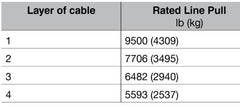Your Cart is Empty
FREE SHIPPING ON ALL WINCH & AIR COMPRESSOR ORDERS
FREE SHIPPING ON ALL WINCH & AIR COMPRESSOR ORDERS
What winch manufactures don’t always tell you!
October 24, 2018 3 min read
If you’re thinking of fitting a winch to your 4x4 for touring, work or play, there are lots of brands and models in the market to consider. One of the most often asked question when customers are looking to purchase a winch is what power rating do I need for my vehicle? The options vary across the brands with 9,000lb, 9,500lb, 12,000lb, 13,000lb, 17,000lb, 25,000lb to name a few.
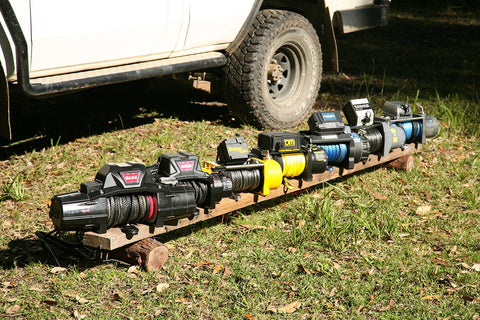
What is often not understood by customers and sales people is that these advertised winch ratings are based on the 1st layer of rope or cable on the winch drum. This is important to understand! What this means is the rating of the winch is reduced as you increase layer on the drum.
For example, a 9,500lb winch will typically hold 4 layers of rope or cable on the drum. Whilst the winch can pull 9,500lb on the 1st layer, this rating drops to about ~5,500lb by the fourth layer.
Winch manufactures will typically instruct you to keep a minimum 5 wraps on the drum at all times so the rope or cable doesn’t slip on the drum. Considering the 1st layer on the drum totals about 5m capacity and some of this capacity isn’t actually available for use due to the 5 wrap rule, there’s a very small window of operation where your winch will achieve its 9,500lb rating. So as long as you’re winching to a recovery point which is exactly the distance away such that you’re on the 1st layer of the winch drum but not on the first 5 wraps, you’re ok! Good Luck!
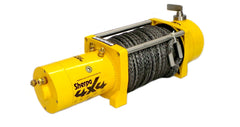
Maybe 5,500lb of power is adequate and you have nothing to worry about? I disagree. From experience I can assure buyers this is not the case. Stalling a 9,500lb winch is easy to do, especially if you’re loaded up in a decent 4WD and you bring other factors into play such as mud, hills, rocks, tree roots etc. Add a camper trailer or towing a boat to the mix and you can quickly reach the capacity of your winch. Also consider you might be using your winch to recover a friend or person you've met stuck on a track who's vehicle could be heavier then yours.
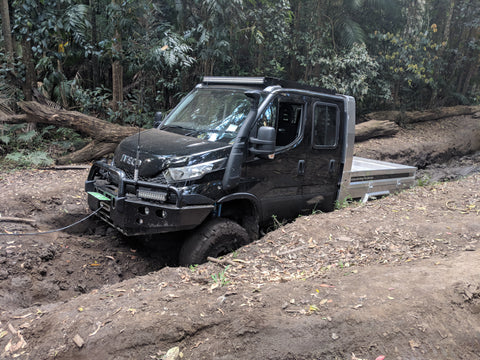
This is why it’s worth considering a higher powered winch such as the Sherpa 17,000lb Steed. For around $1K (Steel cable version $1,099 inc GST, Synthetic rope $1,299 inc GST), you’re getting a winch that comfortably achieves 17,000lb on the 1st layer and this rating drops with wraps to a 4th layer rating which is still over 9,000lb. This additional capacity does come at slight reduction in recovery speed however this is minor and not even noticeable for the frequency I'm recovering my truck. Personally, I don’t consider winching a race and I prefer to know my winch has the power when I need it.
Up my sleeve I also have a winch recovery pulley block and by rigging my winch with this I double the pulling capacity of my winch which further 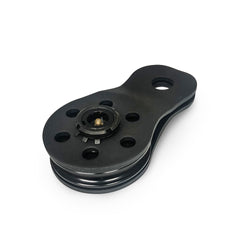 reduces the load on the winch motor and means I can winch for longer with more control. The Sherpa blocks are great as they feature a deep pulley making them perfect for use with both steel cable and synthetic ropes.
reduces the load on the winch motor and means I can winch for longer with more control. The Sherpa blocks are great as they feature a deep pulley making them perfect for use with both steel cable and synthetic ropes.
So in answer to the question, what winch should I consider for my Ford Range, Nissan Navara, Toyota Lancruiser, Hilux, Amarok or even Mitsubishi Pajero, I will always recommend the Sherpa 17,000lb model. This winch fits all leading winch bars on the market without any modifications needed.
In my opinion there are simply no negatives to increasing your winch rating. Just because your winch has the 17,000lb rating, it doesn’t mean you have to use it and if you really do get yourself stuck, your friends 9,000lb winch could be stalling just as your 17,000lb Steed is starting to go to work. Yes it might be possible to bend your bar with this much power but hey, if it means getting my truck out and home safe, I’ll use good winching practices and common sense any day to mitigate this risk and have the confidence my gear is going to get me home.
Written by Ryan from Sherpa Winches Australia.
Leave a comment
Comments will be approved before showing up.
Subscribe
Sign up to get the latest on sales, new releases and more …

